Art Fairs
5 Covetable Objects From Salon Art + Design in New York, From a Giacometti Bronze to a Rare Gio Ponti Cabinet
The 12th edition of the art and design fair runs from November 9–12 at the Park Avenue Armory.
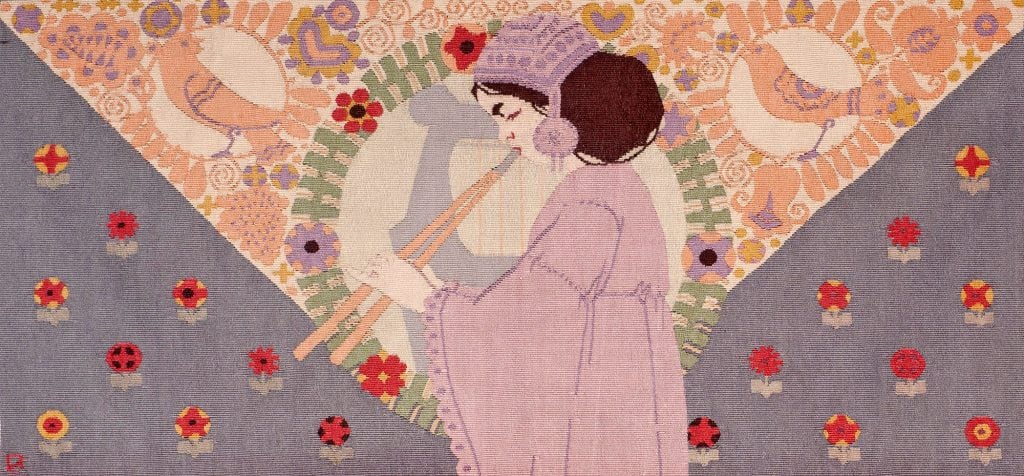
Long a highlight of New York City’s fall arts calendar, Salon Art + Design is back at the Park Avenue Armory for 2023. The 12th edition, taking place from November 9–12, brings together over 50 leading exhibitors in the collectible design space from around the world.
“We want Salon to provide a sense of discovery for our audiences, which includes both seasoned and entry-level collectors alike,” said executive director Jill Bokor. “While Salon is known for showing some of the most world-renowned galleries in design, we also want the fair to serve as a platform for burgeoning galleries who are showcasing some of the most cutting-edge design.”
Newcomer galleries Guy Regal NYC and Mercado Moderno, among others, join returning exhibitors Bernard Goldberg Fine Arts, Cristina Grajales, Galerie Chastel-Maréchal, and Maison Gerard. Together, they present an outstanding array of collectible items ranging from furniture, studio glass, and ceramics to Japanese art and jewelry—an eclectic mix of vintage, modern, and contemporary designs, as well as blue-chip art.
Here, we take a closer look at five of the remarkable objects that will be on view at Salon Art + Design.
Gio Ponti and Piero Fornasetti, Trumeau Cabinet
Donzella, New York
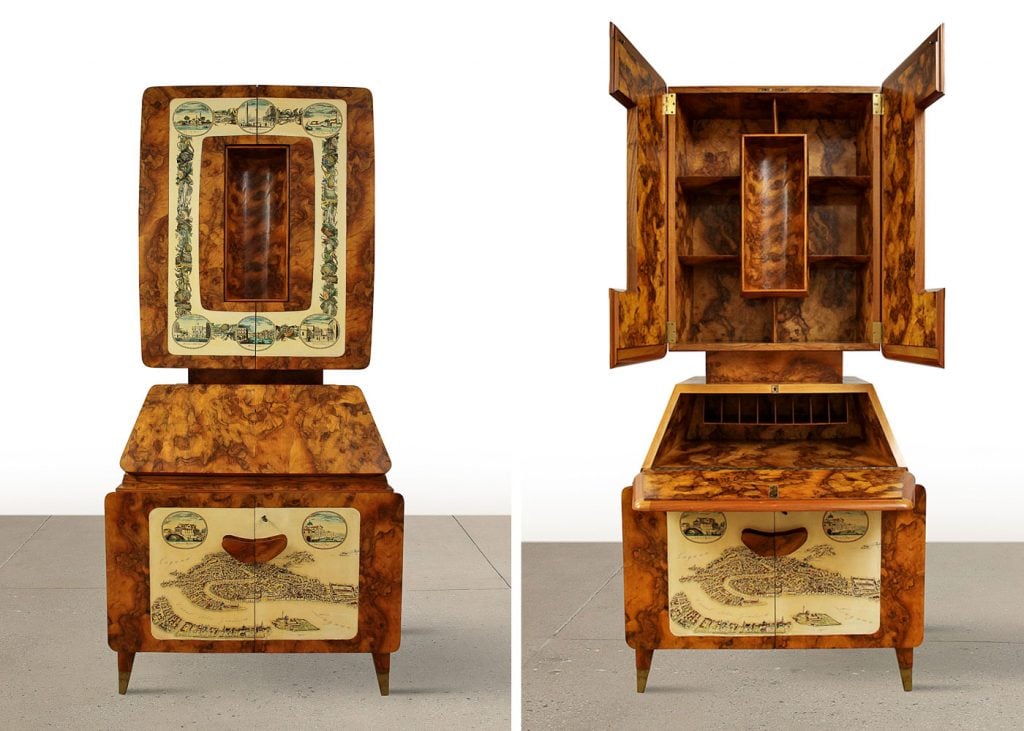
Gio Ponti and Piero Fornasetti, ‘Trumeau’ cabinet (1950).
Brought by Donzella, this extraordinary cabinet, a collaboration between Gio Ponti and his protégé Piero Fornasetti, was made for the Milan home of the Ceccatos—of Dulciora confectionary fame—to display their collection of Chinese porcelains.
“This was during the peak time for these two artists to be working together,” said Paul Donzella. The gallerist noted that its structure—made of walnut root from the Ferrara region of Italy—was designed by Ponti and its surface decorated by Fornasetti, including the lower doors featuring an aerial view of Venice by the 15th-century printmaker Jacopo de’ Barbari. All of the major pieces from the Ceccato house, including this bureau, were built by the master cabinet-maker Giordano Chiesa. “Finding the trifecta of Ponti, Fornasetti, and Chiesa is extremely rare.”
Ponti and Fornasetti have become celebrated icons of 20th-century Italian design. “This was a very avant-garde piece for its time,” added Donzella, “and I believe that Ponti’s idea of mashing up old ideas with a new approach in execution makes it just as avant-garde today.”
This and the other contents of the Ceccato home remained with the family until they were sold at Christie’s London in March 2006, when the cabinet was purchased by famed design dealer Peter Loughrey. Following his death in 2020, it was acquired by Donzella.
Asking price: $240,000
Ted Kurahara, Cadmium Red Medium and Deep
Carole Davenport, New York

Ted Kurahara, Cadmium Red Medium and Deep (2015).
Carole Davenport, a specialist in Japanese art, has brought a striking crimson-red painting by the artist Ted Kurahara, who just celebrated his 98th birthday yet continues to pick up the paintbrush, said the dealer. Kurahara started his characteristically layered, enigmatic blocks of color with a series of white paintings in 1981. These contemplative works derive from a variety of inspirations, most notably haiku poetry, which his father wrote and he himself makes a point of reading.
The subtle variations between light and dark in Kurahara’s monochromes lend depth and dimension, blending contemporary American abstraction with traditional Japanese mark-making. “[Since] the 8th century,” said Davenport, “small wooden pagodas were created as devotional images for important temples in the Buddhist faith. They are a testament to the Japanese attention to clarity of form and design.”
Asking price: over $45,000
Rudolf Livora, Girl With Flute Tapestry
Bernard Goldberg Fine Arts, East Hampton
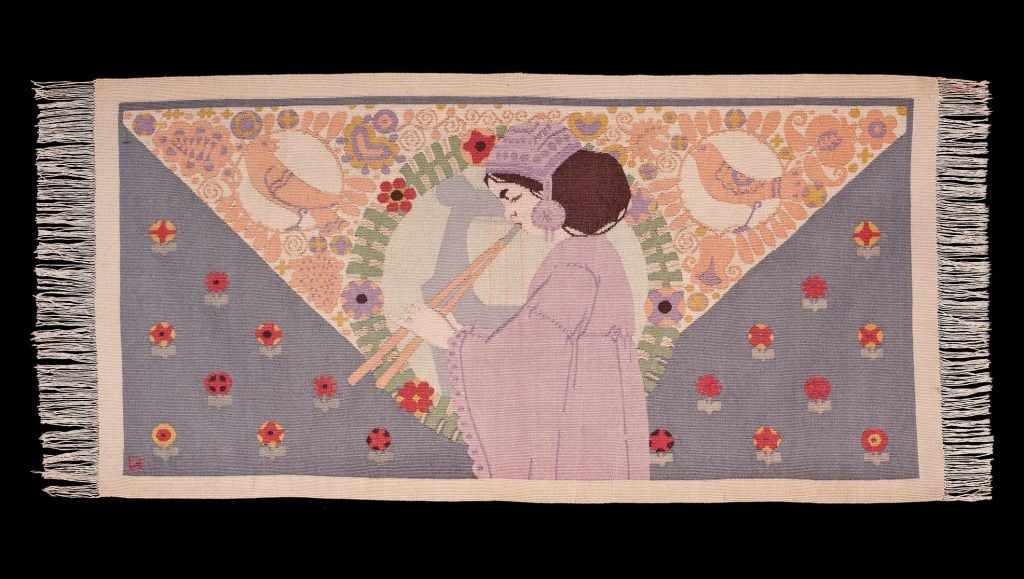
Rudolf Livora, Girl With Flute tapestry (ca. 1908).
As the Arts and Crafts movement swept across Europe at the turn of the 20th century, cottage industries sprung up as part of a socially conscious program to bring meaningful jobs to remote areas. This was the case with the Czech region of Moravia, where the painter and teacher Rudolf Livora lived and worked. He was one of the key designers at the Tapestry Manufactory, a center for woven works of modern design, where he created this mesmerizing tapestry, Girl With Flute (ca. 1908), using multiple colors, intricate patterns, and hand-woven techniques.
Livora was also a puppeteer inspired by the traditional handicrafts of Moravia, a corner of southeastern Czechoslovakia known for its folklore, music, and puppetry. His work designing for the Czech Association of Puppet Theatre Friends and the Sokol Hodonín Puppet Theatre, which he founded and directed, reflect his interest in the popular art.
Asking price: $115,000
Alberto Giacometti, Oblong Cup
Galerie Mathivet, Paris
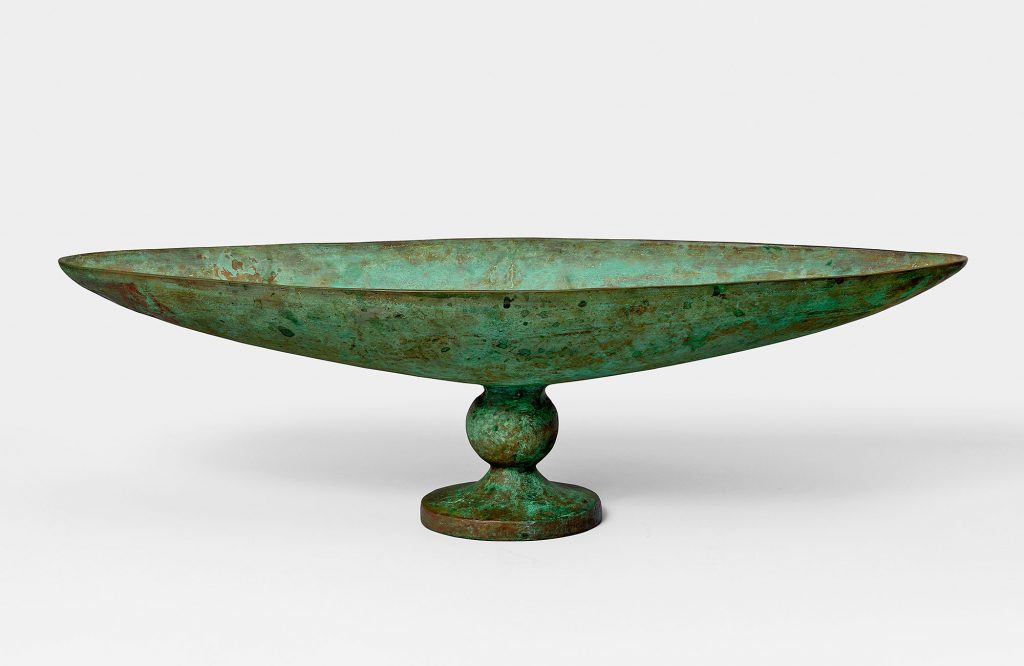
Alberto Giacometti, Oblong Cup (1949).
This Oblong Cup by Alberto Giacometti comes courtesy of Paris-based Galerie Mathivet, a first-time exhibitor at Salon Art + Design. Much like his Cubist sculptures, such as his bronze Spoon Woman of 1927, Giacometti shaped the cup by overlapping geometric elements.
The generously proportioned cup is a prime example of Giacometti’s fascination with the lines of ancient Egyptian objects, according to gallerists Céline and Fabien Mathivet. He discovered Egyptian art in the late 1910s during his travels to Venice, but it was a visit to the archaeological museum of Florence in 1920 that he become entranced—two years before the discovery of King Tutankhamun’s tomb in the Valley of the Kings.
His passion for Egyptian art was no passing fancy, but a constant influence in his work. He was particularly influenced by the aesthetic principles of ancient Egypt—the straightforward gazes, upright postures, and hieratic poses (arms alongside the body and joined feet).
According to the gallery, only three Oblong Cups can be found in the Giacometti Foundation database. The other two had a different patina, such as one belonging to the French couturier Hubert de Givenchy that exhibits a gold shimmer rather than the antique green patina seen here.
Asking price: upon request
Jean Royère Armchairs
Galerie Gabriel, New York
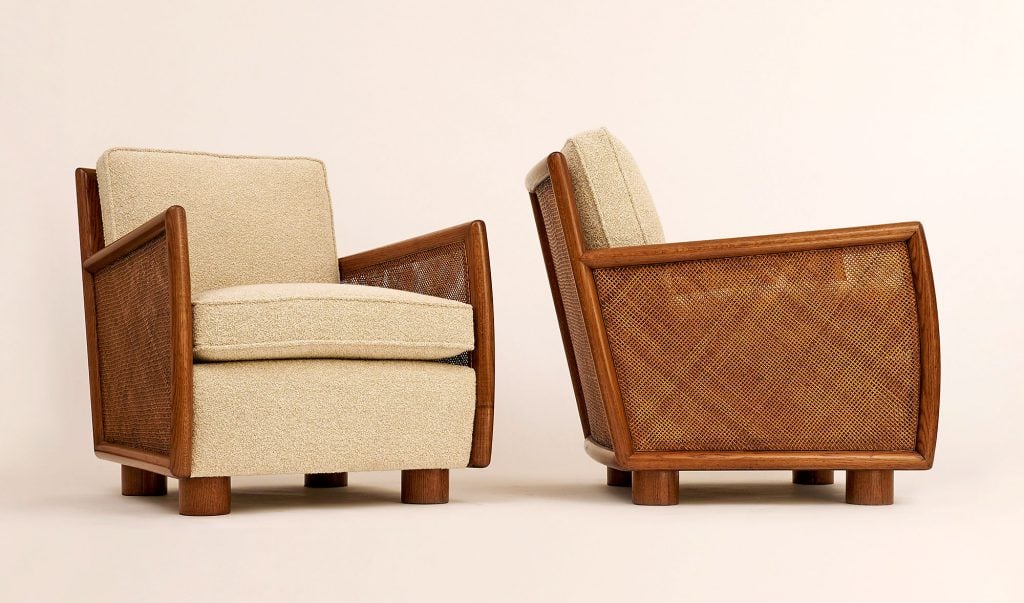
Jean Royère armchairs (ca. 1950s).
The French interior designer Jean Royère first found success when, in 1934, he won a contest to design the brasserie of the Hotel Carlton on the Champs-Élysées in Paris. That allowed him to create his own company in 1944, designing custom furniture for high-end clients and opening offices in Cairo, Beirut, Teheran, and São Paulo. Royère had a gift for combining whimsy (think: round sofas and furry chairs) with more traditional components, bridging the gap between past and future.
Royère’s ability to blend modernity and classicism is on full display in two armchairs brought by Galerie Gabriel, based in Paris. Their most striking feature is the use of a woven cane wood pattern, providing a tactile contrast to the French oak frame. The intricacy of the caning, coupled with the sturdy frame, exemplify Royère’s balance of artisanal craftsmanship and modern design, and underscores his deep appreciation for the natural world.
Though influential during his lifetime, his designs began to fall out of favor following his death in 1981. That is, until 1999, when the Musée des Arts Décoratifs in Paris held a major show of his work. In 2008, Sonnabend Gallery in New York mounted a comprehensive retrospective of over 100 pieces. Then, in March 2023, a full comeback took place with the Adam Lindemann auction at Christie’s New York, according to the Artnet Price Database. Jean Royère’s Polar Bear set of round furniture (ca. 1952), still in its original mohair fabric upholstery, sold for $3.42 million (fees included), doubling its presale estimate.
Asking price: $380,000





